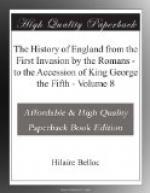[Footnote 2: Petty, Polit. Arithmetic, 29.]
under the government of a Catholic sovereign, whose enmity they had provoked, to the green fields of Erin, and all the benefits which they might derive from the fostering care and religions creed of the protector.[1]
III. By an act,[a] entitled an act for the settlement of Ireland, the parliament divided the royalists and Catholics into different classes, and allotted to each class an appropriate degree of punishment. Forfeiture of life and estate was pronounced against all the great proprietors of lands, banishment against those who had accepted commissions; the forfeiture of two-thirds of their estates against all who had borne arms under the confederates of the king’s lieutenant, and the forfeiture of one-third against all persons whomsoever who had not been in the actual service of parliament, or had not displayed their constant good affection to the commonwealth of England. This was the doom of persons of property: to all others, whose estates, real and personal, did not amount to the value of ten pounds, a full and free pardon was graciously offered.[2]
Care, however, was taken that the third parts, which by this act were to be restored to the original proprietors, were not to be allotted to them out of their former estates, but “in such places as the parliament, for the more effectual settlement of the peace of the nation, should think fit to appoint.” When the first plan of extermination had failed, another project was adopted of confining the Catholic landholders to Connaught and Clare, beyond the river Shannon, and of dividing the remainder of the island, Leinster, Munster, and Ulster, among Protestant colonists. This, it
[Footnote 1: Hutchinson, Hist. of Massachusetts, 190. Thurloe, iii. 459.]
[Footnote 2: Journals, Aug. 12, 1652. Scobell, ii. 197, Ludlow, i. 370. In the Appendix I have copied this act correctly from the original in the possession of Thomas Lloyd, Esq. See note (F).]
[Sidenote a: A.D. 1652. Aug. 12.]




